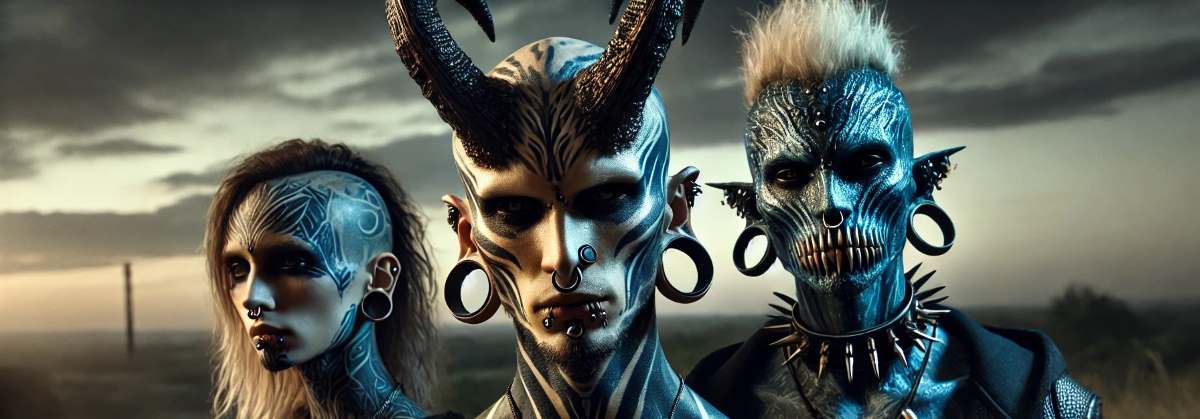Body modification, a profound and fascinating subject, has been practiced across cultures and throughout history, often serving as a potent form of expression, self-identity, and societal marking.
Body Modification?
Body modification is the deliberate alteration of one’s physical appearance or human anatomy. This practice spans across a spectrum from socially acceptable adornments like tattoos and piercings to more extreme forms such as scarification and surgical alterations.
Historical Perspective of Body Modification
Body modification has ancient roots and is often intertwined with cultural, religious, and personal beliefs. From early civilizations’ use of cranial deformation and tooth filing to modern practices of tattooing and piercing, the human body has been a canvas for expressing varied aspects of identity and societal status.
Understanding Body Modification Across Cultures
Body modification practices differ significantly across cultures. For instance, it includes practices like nose piercing in Hindu culture, neck elongation in Thailand and Africa, and henna tattooing in Southeast Asia and the Middle East. Each of these practices bears unique cultural significance and is often part of rites of passage or religious rituals.
Body Modification and Aesthetics
A significant aspect of body modification is the pursuit of beauty or a particular aesthetic. Many cultures have traditions that involve modifying the body to enhance physical attractiveness, express creativity, or adhere to societal beauty norms. However, it’s crucial to note that these beauty standards vary widely across different societies and historical periods.
Body Modification as a Form of Self-expression
In many contemporary societies, especially in the Western world, body modification has evolved into a form of self-expression. Practices such as tattooing, body piercing, and scarification have become increasingly popular, transitioning from the margins of society to mainstream acceptance. These forms of body modification allow individuals to assert their identities and enhance their body image.
The Modern Primitive Movement
The “modern primitive” movement is a contemporary trend that blends tribal traditions with modern aesthetics. Participants in this movement engage in various body modification practices, using their bodies as canvases for artistic and personal expression. This movement reflects a desire to connect with ancient practices and rituals, often perceived as more authentic or spiritually fulfilling than modern societal norms.
Body Modification and Health Risks
While body modification can be a powerful form of personal and cultural expression, it is not without potential health risks. Complications can range from localized infections and allergic reactions to more serious issues like transmission of diseases. It’s essential for individuals considering body modification to be aware of these risks and to ensure that any procedures they undergo are performed under safe, hygienic conditions.
The Role of Body Modification in Today’s Society
In today’s society, body modification is becoming more accepted and mainstream. However, it can still be a source of social stigma and misunderstanding. Individuals who choose to modify their bodies often face judgments or stereotypes, and may even be ostracized from certain social groups. Despite these challenges, many people find body modification to be a powerful tool for self-expression and identity formation.
The Future of Body Modification
The future of body modification is likely to continue evolving as societal attitudes, fashion trends, and technologies change. Innovations in fields such as bioengineering and cosmetic surgery are opening up new possibilities for body modification, potentially blurring the lines between natural and artificial, human and machine. As we move forward, it will be fascinating to see how these trends develop and how society’s views on body modification continue to evolve.

FAQs about body modification:
1. What is body modification?
Body modification refers to the deliberate altering of the human body for aesthetic, cultural, or personal reasons. It includes practices such as tattoos, piercings, implants, scarification, and other forms of physical transformation.
2. What are some common types of body modification?
Common types include tattoos, piercings, scarification, branding, subdermal implants, tongue splitting, and ear stretching. Each type serves different cultural, aesthetic, or personal purposes.
3. Is body modification safe?
Safety depends on the procedure, the expertise of the practitioner, and aftercare. It’s important to choose a reputable professional, ensure proper sterilization, and follow all aftercare instructions to minimize risks like infection or scarring.
4. Why do people choose to undergo body modification?
People choose body modification for various reasons, including self-expression, cultural or religious beliefs, aesthetic preferences, to mark life experiences, or to align with specific subcultures or communities.
5. Are there risks associated with body modification?
Yes, risks can include infection, allergic reactions, scarring, nerve damage, and complications during healing. Some modifications may also have social or professional implications.
6. How do I choose a reputable body modification artist?
Look for an artist with a strong portfolio, positive reviews, and proper licensing. Ensure they follow strict hygiene practices and are experienced in the specific type of modification you’re seeking.
7. What should I know about aftercare for body modifications?
Aftercare varies by procedure but generally includes keeping the area clean, avoiding harsh chemicals, and following specific instructions from the artist to promote healing and prevent infection.
8. Can body modifications be reversed?
Some body modifications, like piercings and certain implants, can be reversed, but others, such as tattoos or scarification, are more permanent. Reversal options, like tattoo removal, can be costly, painful, and may not completely restore the skin to its original state.
9. How do cultural views on body modification vary?
Cultural views on body modification differ widely. In some cultures, certain modifications are traditional or symbolic, while in others, they may be seen as unconventional or taboo. Attitudes can vary significantly depending on social, religious, and cultural contexts.
10. Are there legal restrictions on body modification?
Laws regarding body modification vary by region. Some areas have age restrictions, licensing requirements for practitioners, and regulations on specific types of modifications. It’s important to understand the legalities in your area before undergoing any procedure.


